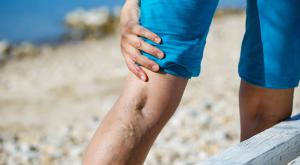Varicose veins are enlarged, distorted veins caused by blood collecting and building up in one’s legs. This happens when one’s veins and valves weaken, and are thus unable to facilitate the smooth flow of blood from one’s legs up to the heart and back.
Besides being a cosmetic problem, varicose veins can be painful. Severe long-standing varicose veins can lead to leg swelling, venous eczema, skin thickening (lipodermatosclerosis), and ulceration. Life-threatening complications are uncommon, but varicose veins may be confused for deep vein thrombosis, which is life-threatening.

Are you prone to varicose veins?
The sad truth is, varicose veins often run in families. If you noticed you grandfather, aunt, or mother having those obvious risen veins on their legs, you run a higher risk of having them yourself. Factors that can increase your risk for varicose veins include being overweight, not exercising enough, smoking, standing or sitting for long periods of time, or having deep vein thrombosis.
Women are more likely than men to develop varicose veins. Varicose veins usually affect people between the ages of 30 and 70. Aging also increases your chances of getting them eventually. High blood pressure inside your superficial leg veins causes varicose veins. Pregnant women have an increased risk of developing varicose veins, but the veins often return to normal within 1 year after childbirth. Women who have multiple pregnancies may develop permanent varicose veins.
More than just a vanity issue
Aside from it being unattractive, varicose veins often cause other more painful problems. People who have it experience heaviness, burning, aching, tiredness, or pain in their legs. Symptoms may be worse after one stands or sits for long periods of time. This results in swelling in the feet and ankles itching and scaling over the vein. Sometimes, they can develop open sores, or bleeding after a minor injury.
Treatment for Varicose Veins
Non-surgical treatments include sclerotherapy, elastic stockings, elevating the legs, and exercise. The traditional surgical treatment has been vein stripping to remove the affected veins. But newer, less invasive treatments which seal the main leaking vein are available.
Some of the available alternative techniques are ultrasound-guided foam sclerotherapy, radiofrequency ablation, and the more advisable endovenous laser treatment.
Endovenous Laser Treatment at MyHealth Clinic
MyHealth Clinic now offers “Endovenous Laser Treatment” (EVLT), which is a minimally invasive ultrasound-guided technique used for treating varicose veins using laser energy,” according to Paul Montemayor, MD, a US-trained vascular surgeon. “It is a minimal invasive method to treat saphenous varicose veins.”
“A thin laser fibre or radiofrequency (RF) catheter is passed into the faulty (saphenous) vein. The laser fiber tip (or, in RF, the heating electrode) heats up and “fries” the inner vein wall, closing the vein down and seal off entirely. It will at some point be absorbed by the body’s all-natural processes. Recurrence is possible, but not very likely,” continues Montemayor.
At MyHealth Clinic, a patient must undergo a thorough medical check and diagnosis to determine if the procedure is appropriate for his/her medical condition. It is recommended for people above 35, male or female, provided they merit the approval of their doctor.
“One major advantage that make it a better choice to get rid of varicose veins is its very minimal invasion. A tiny skin nick is all it takes–no incisions. Only local anaesthesia is used, so the patient is safe as he/she is fully awake,” adds Montemayor. “Treatment time is a mere 20 minutes per leg, which means the patient can immediately return to work, because it is an outpatient procedure.“
Dr. Montemayor is proud of his services’ high patient satisfaction. Results are quite surprising.
However, like all other treatments, there are some risks which the patient must take into consideration. While endovenous laser therapy is a very safe procedure, potential but rare side effects include damage to a blood vessel, bruising, bleeding, or infection at the puncture site. “MyHealth Clinic is fully equipped and able to respond should these uncommon occurrences happen,” Montemayor discloses.
For more inquiries and information, email us at myhealth@myhealth.ph.

